Spatial and Temporal Distribution Characteristics and Influencing Factors of Red Industrial Heritage in Hebei, China
Abstract
1. Introduction
- Historical Dimension: The history spans from the founding of the Communist Party of China in 1921 to the early industrialization period of the People’s Republic of China.
- Material Dimension: This includes physical remains such as factories, mines, and production equipment, as well as non-material elements like related technical archives.
- Connotative Dimension: It witnesses major turning points or significant events in the Party’s history, playing a key role in the Party’s leadership in the country’s modernization.
- Value Dimension: It holds historical value of the Party, along with multiple other value dimensions, including architectural aesthetic value, locational value, historical value, regional cultural value, and value in the history of technology.
- Systematically analyzing the spatial regulatory role of policy orientation on Red Industrial Heritage distribution by combining qualitative and quantitative research;
- Revealing the dynamic coupling mechanism between heritage distribution and industrialization processes through the spatial reconstruction of multi-source historical geographical data (topography, transportation, policy texts);
- Proposing tiered conservation strategies based on spatiotemporal differentiation patterns, promoting a shift from “passive rescue” to “proactive planning” in heritage preservation, and fostering its sustainable development.
2. Research Methods
2.1. Data Collection
2.2. Research Design
2.2.1. Kernel Density Estimation
2.2.2. Spatial Autocorrelation Analysis
2.2.3. Mean Centre and Standard Deviational Ellipse
3. Results
3.1. Spatiotemporal Distribution Characteristics
3.1.1. Historical Phases
3.1.2. Spatial Distribution Characteristics
- (1)
- Overall Spatial Distribution Characteristics
- (2)
- Spatial Distribution Characteristics in Different Periods
3.1.3. Evolution of Centers and Spatial Shifts of Red Industrial Gravity
3.2. Typological Spatial Distribution Characteristics
- Traffic and transportation heritage accounts for 26.25%, primarily concentrated in Zhangjiakou and Shijiazhuang (Figure 7a). During the period from 1861 to 1911, this type of heritage saw the most new additions, corresponding to the construction of essential transportation lines, such as the Tangxu Railway, Zhengtai Railway, Pinghan Railway, and Jingzhang Railway. These railways promoted the development of railway hub cities, such as Shijiazhuang.
- Military industrial heritage accounts for 18.75%, and is concentrated in the revolutionary base areas in the interior of the Taihang Mountains (Figure 7b). This type of heritage saw the highest number of additions during the War of Resistance Against Japanese Aggression, the First Five-Year Plan, and the Third Front Construction, providing crucial rear-area support for victory.
- Financial heritage accounts for 17.5%, with a distribution pattern similar to that of military industrial heritage (Figure 7c), and saw the most additions during the War of Resistance Against Japanese Aggression. During the war, banks were established in the Jin-Ji-Lu-Yu and Jin-Cha-Ji border areas, and counterfeit currency was eliminated while border currency was issued [50]. This helped break the economic blockade imposed by the enemy and established an independent financial system, providing strong support for the survival and development of the war in the areas behind the enemy lines [51].
- Mining heritage accounts for 12.5%, primarily located in areas rich in mineral resources, such as Chengde, Tangshan, Shijiazhuang, and Handan (Figure 7d). This type of heritage saw significant additions during the periods of 1861–1911 and 1950–1978.
- Printing and publishing heritage accounts for 5%, with its scope of activities (such as printing currency) closely related to financial heritage. The appearance period and distribution range of this type of heritage are also similar to those of financial heritage (Figure 7e), and both were key measures of the Communist Party’s political, economic, and cultural struggle in the base areas behind the enemy lines.
- Power industry’s heritage accounts for 5% and is distributed in industrial cities such as Shijiazhuang, Qinhuangdao, and Zhangjiakou (Figure 7f). It played a foundational role for other industries and saw additions during all four periods from 1912 to 1978.
- Chemical and pharmaceutical heritage accounts for 5%, with distribution primarily in Shijiazhuang and Baoding (Figure 7g). The majority of new additions occurred during the First Five-Year Plan, which promoted the growth of China’s light industry and contributed to improvements in people’s livelihoods.
- Communication heritage accounts for 3.75%, with distribution in Shijiazhuang and Handan (Figure 7h). The number of additions was concentrated during the Liberation War, where the red radio waves supported the three major campaigns of the war.
- Heritage from other manufacturing industries, such as textiles, food, metallurgy, papermaking, and building materials, is relatively small in number but is distributed across several periods (Figure 7i), contributing to the diverse industrial heritage system of the red industry in Hebei Province.
3.3. Influencing Factors Analysis
3.3.1. Historical and Policy Factors
3.3.2. Natural Resource Factors
3.3.3. Transportation Factors
3.3.4. Topographic Factors
4. Discussion
4.1. Spatiotemporal Distribution Patterns
4.2. Driving Mechanisms
4.3. Protection and Revitalization Strategies
4.4. Research Boundaries and Future Directions
5. Conclusions
Author Contributions
Funding
Institutional Review Board Statement
Informed Consent Statement
Data Availability Statement
Conflicts of Interest
Abbreviations
| GIS | Geographic Information System |
| TICCIH | The International Committee for the Conservation of the Industrial Heritage |
| API | Application Programming Interface |
| PLA | People’s Liberation Army of China |
| CPC | Communist Party of China |
References
- Yan, M.; Li, Q.; Zhang, J. Rethinking Industrial Heritage Tourism Resources in the EU: A spatial perspective. Land 2023, 12, 1510. [Google Scholar] [CrossRef]
- Avrami, E.; Macdonald, S.; Mason, R.; Myers, D. Values in Heritage Management: Emerging Approaches and Research Directions; The Getty Conservation Institute: Los Angeles, CA, USA, 2019. [Google Scholar]
- Labadi, S.; Logan, W. Approaches to urban heritage, development and sustainability. In Urban Heritage, Development and Sustainability; Routledge: Oxfordshire, UK, 2015; pp. 1–20. [Google Scholar]
- Xie, P.F. Industrial Heritage Tourism; Channel View Publications: North York, ON, Canada, 2015; Volume 43. [Google Scholar]
- Cheng, S.M.; Bowring, J. Rust, Dust, Smoke and Smell: Memoryscapes for Industrial Heritage. Herit. Soc. 2024, 17, 413–438. [Google Scholar] [CrossRef]
- The International Committee for the Conservation of the Industrial Heritage (TICCIH). The Nizhny Tagil Charter For The Industrial Heritage. 2003. Available online: https://ticcih.org/about/charter/ (accessed on 15 March 2025).
- Lu, N.; Min, L.; Wang, R. Reproducing the discourse on industrial heritage in China: Reflections on the evolution of values, policies and practices. Int. J. Herit. Stud. 2020, 26, 498–518. [Google Scholar] [CrossRef]
- Qian, Z. Heritage conservation as a territorialised urban strategy: Conservative reuse of socialist industrial heritage in China. Int. J. Herit. Stud. 2023, 29, 63–80. [Google Scholar] [CrossRef]
- Han, H. Outline of the Red Industrial Heritage: Based on the Perspective of the Communist Party of China Leading the National Modernization. Urban Dev. Stud. 2021, 28, 62–68. [Google Scholar]
- Ciprian, C.C. Communist heritage tourism and red tourism: Concepts, development and problems. Cinq Cont. 2011, 1, 29–39. [Google Scholar]
- Urban Planning Society of China. The Third Batch of China’s Industrial Heritage Protection List Released. Available online: https://www.planning.org.cn/news/view?id=14513 (accessed on 16 April 2025).
- Ministry of Industry and Information Technology of the People’s Republic of China. Notice of the Ministry of Industry and Information Technology of the State Administration of Cultural Heritage on the Announcement of the List of Typical Cases of Protecting and Utilizing Witnesses of the “Seal of the Republic” and Industrial Heritage. Available online: https://www.miit.gov.cn/jgsj/zfs/gzdt/art/2024/art_170582e464234feb96b9b83aff76c05e.html (accessed on 15 March 2025).
- Zhong, M. Research on Industrial Heritage Renewal Strategy Based on “Place Event” Theory—Taking Anyuan Coal Mine as an Example. Master’s Thesis, Jiangxi Normal University, Nanchang, China, 2021. [Google Scholar]
- Zhao, Y. Research on Spatial Optimization of Red Industrial Heritage Based on Spatial Syntax—Taking Daqing Hongqi Village Gandalei Building Complex as an Example. Master’s Thesis, University of South China, Hengyang, China, 2023. [Google Scholar]
- Zhong, Z. Research on Ecological Protection and Reuse of Industrial Heritage in the Central Soviet Area of Southern Jiangxi. Master’s Thesis, Jiangxi University of Science and Technology, Ganzhou, China, 2021. [Google Scholar]
- Li, Z. Research on the Effective Realization of the Ideological and Political Education Function of Red Industrial Heritage. Master’s Thesis, Guilin University of Electronic Technology, Guilin, China, 2024. [Google Scholar]
- Han, H. On the Mechanism and Path of the Red Industrial Heritage in the Role of the Dissemination of the Spiritual Genealogy of Chinese Communists. J. Cent. China Norm. Univ. (Humanit. Soc. Sci.) 2022, 61, 71–78. [Google Scholar] [CrossRef]
- Liu, J.; Duan, Y.; Wang, Y. Investigation and Characteristic Analysis of the Status Quo of Red Industrial Heritage in Jiangxi. Urban Archit. 2021, 18, 80–83+100. [Google Scholar] [CrossRef]
- Ma, X.; Zhang, Y.; Li, Y.; Li, Y.; Lin, F. Spatial–temporal distribution and evolution of the socialist built heritage in China, 1949–1978. Herit. Sci. 2023, 11, 214. [Google Scholar] [CrossRef]
- Wang, N. Research on the Evolution and Planning Response of “156 Projects” in Emerging Industrial Cities in Northwest China—Taking Lanzhou and Xi’an as Examples. Master’s Thesis, Lanzhou Jiaotong University, Lanzhou, China, 2022. [Google Scholar]
- Yan, M. The Research of Industrial Heritage Cluster in Tianjin as the Center of the Zhili Province. PhD. Thesis, Tianjin University, Tianjin, China, 2015. [Google Scholar]
- Bekus, N.; Cowcher, K. Socialism, Heritage and Internationalism after 1945. The Second World and Beyond. Int. J. Herit. Stud. 2020, 26, 1123–1131. [Google Scholar] [CrossRef]
- Kochetkova, E.; Petrova, A. Abandoned, but not forgotten heritage: Former industrial enterprises in cultural and urban Russian landscapes. Herit. Soc. 2022, 15, 277–298. [Google Scholar] [CrossRef]
- Petrović, T. Heritage of liminality: Remnants of the military in the Istrian city of Pula in the aftermath of Yugoslav socialism. In Colloquia Humanistica; Instytut Slawistyki Polskiej Akademii Nauk: Warsaw, Poland, 2021; pp. 1–21. [Google Scholar] [CrossRef]
- Venovcevs, A. Living with socialism: Toward an archaeology of a post-soviet industrial town. Extr. Ind. Soc. 2021, 8, 100835. [Google Scholar] [CrossRef]
- Wang, Y. The Industrial Heritage Survey and Value Evaluation of Hebei Province. Master’s Thesis, Hebei University of Engineering, Handan, China, 2018. [Google Scholar]
- Jiang, T. Modern Chinese History, 1st ed.; Tianjin People’s Publishing House: Tianjin, China, 2016. [Google Scholar]
- Liu, B.; Wu, C.; Xu, W.; Shen, Y.; Tang, F. Emerging trends in GIS application on cultural heritage conservation: A review. Herit. Sci. 2024, 12, 139. [Google Scholar] [CrossRef]
- Wang, H.; Chen, X.; Ge, J.; Yan, Z.; He, X.; Song, Y.; Zhou, Q. Research on the spatiotemporal distribution and cultural tourism strategy of modern educational architectural heritage in Nanjing. Sustainability 2023, 15, 14392. [Google Scholar] [CrossRef]
- Fan, X.; Sun, L. Geographic distribution characteristics and influencing factors for industrial heritage sites in Italy based on GIS. Sustainability 2024, 16, 2085. [Google Scholar] [CrossRef]
- Li, X. Determination of the temporal-spatial distribution patterns of ancient heritage sites in China and their influencing factors via GIS. Herit. Sci. 2024, 12, 143. [Google Scholar] [CrossRef]
- Yang, D.; Liu, X. A Framework for Mapping Urban Spatial Evolution: Quantitative Insights from Historical GIS and Space Syntax in Xi’an. Sustainability 2025, 17, 3113. [Google Scholar] [CrossRef]
- Liu, S.; Liu, Y.; Zhang, R.; Cao, Y.; Li, M.; Zikirya, B.; Zhou, C. Heterogeneity of Spatial Distribution and Factors Influencing Unattended Locker Points in Guangzhou, China: The Case of Hive Box. ISPRS Int. J. Geo-Inf. 2021, 10, 409. [Google Scholar] [CrossRef]
- Liu, W.; Xue, Y.; Shang, C. Spatial distribution analysis and driving factors of traditional villages in Henan province: A comprehensive approach via geospatial techniques and statistical models. Herit. Sci. 2023, 11, 185. [Google Scholar] [CrossRef]
- Anselin, L. Local indicators of spatial association—LISA. Geogr. Anal. 1995, 27, 93–115. [Google Scholar] [CrossRef]
- Zhang, J.; Zhuo, L.; Sun, H.; Wang, Y.; Wei, H.; Xu, S.; Aoki, N. Construction of the Chinese Route of Industrial Heritage Based on Spatial and Temporal Distribution Analysis. Buildings 2024, 14, 1065. [Google Scholar] [CrossRef]
- Chen, M.; Wang, J.; Sun, J.; Ye, F.; Zhang, H. Spatio-temporal distribution characteristics of intangible cultural heritage and tourism response in the Beijing-Hangzhou Grand Canal Basin in China. Sustainability 2023, 15, 10348. [Google Scholar] [CrossRef]
- Liu, Y.; Luo, T. Exploring the Temporal, Spatial and Characteristic Trends and Key Influencing Factors of Tianjin’s Industrial Heritage. Sustainability 2024, 16, 9267. [Google Scholar] [CrossRef]
- Zhu, C. The History of Modern Chinese Industry; Chongqing Publishing House: Chongqing, China, 1989. (In Chinese) [Google Scholar]
- Tan, K. History of Chinese Revolutionary Base Areas; Fujian People’s Publishing House: Fuzhou, China, 2007. (In Chinese) [Google Scholar]
- Wang, J. China’s Early Modern Industrial History Data; Science Press: Beijing, China, 1957. (In Chinese) [Google Scholar]
- Liu, S. On the Military-Industrial Development in Late Qing China. Mil. Hist. Res. 1991, 1, 96–111. (In Chinese) [Google Scholar]
- Editorial Committee of the Workers’ Movement History in ‘Sanjin’ Revolutionary Base Areas. A History of the Labor Movement in the Jin-Cha-Ji Revolutionary Base Area; China Workers’ Publishing House: Beijing, China, 1992. (In Chinese) [Google Scholar]
- Yin, Q. Between the mountains, the city, and the world: The microhistory of a ‘Small Third Front’ Chinese arsenal during Revolution and reform. Labor Hist. 2024, 65, 457–475. [Google Scholar] [CrossRef]
- Xu, Y.; Zhuang, Z. Research on China’s regional layout of manufacturing factories in the 1930s: A joint discussion on the spatial and scale quality improvement process of industrialization in a late-developing country. J. Mod. Chin. Hist. 2023, 17, 226–243. [Google Scholar] [CrossRef]
- GB 4754–84; National Economic Industry Classification and Codes. National Bureau of Statistics, Original National Bureau of Standards, Original State Planning Commission, Ministry of Finance of the People’s Republic of China: Beijing, China, 1984.
- GB/T 4754–2017; National Economic Industry Classification. Original Administration of Quality Supervision, Inspection and Quarantine, National Standardization Administration: Beijing, China, 2017.
- Liu, F. Study on classification system of modern industrial heritages in China. Urban Dev. Stud. 2015, 22, 64–71. [Google Scholar]
- Meng, F.; Xiao, X. Spatiotemporal Distribution and Adaptive Reuse Results Assessment of Beijing Industrial Heritage Based on the Sustainable Renewal Perspective. Land 2025, 14, 384. [Google Scholar] [CrossRef]
- Party History Research Office of Hebei Provincial Committee of the Communist Party of China; Party History Research Office of Handan Municipal Committee of the Communist Party of China. Historical Materials Compilation and Research on Economic Development of the Eighth Route Army 129th Division and the Jin-Ji-Lu-Yu Revolutionary Base Area; Hebei People’s Publishing House: Shijiazhuang, China, 2019. (In Chinese) [Google Scholar]
- Tang, X.; Li, C. The Currency Struggle in the Jin-Cha-Ji Border Region. Hebei Financ. 2022, 30, 44–48. [Google Scholar] [CrossRef]
- Brenner, N. State territorial restructuring and the production of spatial scale: Urban and regional planning in the Federal Republic of Germany, 1960–1990. Political Geogr. 1997, 16, 273–306. [Google Scholar] [CrossRef]
- Gao, Y.; Tan, G.; Zhu, J.; Chen, Z. Spatial distribution and determinants of Third Front built heritage: Insights from West Hubei Province, China. NPJ Herit. Sci. 2025, 13, 304. [Google Scholar] [CrossRef]
- Weber, A. Theory of the Location of Industries; University of Chicago Press: Chicago, IL, USA, 1929. [Google Scholar]
- Galgano, F.; Palka, E.J. Modern Military Geography; Routledge: New York, NY, USA, 2012. [Google Scholar]
- Handan Local Chronicles Compilation Committee. Gazetteer of Handan City; CPC History Publishing House: Beijing, China, 2018. (In Chinese) [Google Scholar]
- Xiao, F.; Han, S.; Committee, H.P.L.C.C. Hebei Provincial Gazetteer: Military Affairs; Military Science Publishing House: Beijing, China, 2000. (In Chinese) [Google Scholar]
- Xia, D. History of the Westernization Movement; East China Normal University Press: Shanghai, China, 1992. (In Chinese) [Google Scholar]
- Liao, H.; Li, X. Status and Trends of Research on China’s Third Front Construction in English Language and Brief Comparison With Chinese Counterpart. SAGE Open 2023, 13, 21582440231157614. [Google Scholar] [CrossRef]
- Lüthi, L. The Vietnam War and China’s third-line defense planning before the Cultural Revolution, 1964–1966. J. Cold War Stud. 2008, 10, 26–51. [Google Scholar] [CrossRef]
- Youwei, X. Exploring New Frontiers in Contemporary Chinese History Studies: A Case Study of Third Front Construction. Soc. Sci. China 2020, 41, 164–182. [Google Scholar] [CrossRef]
- Hebei Provincial Local Chronicles Compilation Committee. Hebei Provincial Gazetteer: Geology and Mineral Resources; Hebei People’s Publishing House: Shijiazhuang, China, 1991; Volume 7. (In Chinese) [Google Scholar]
- Wang, Y.; Wang, X.; Zhang, W.; Man, W.; Liu, M.; Jiao, L. Spatiotemporal evolution of landscape ecological risk and its driving factors of the Beijing–Tianjin–Hebei major mineral belt, 1985–2022. Sci. Rep. 2025, 15, 2425. [Google Scholar] [CrossRef]
- Yu, C.; Li, H.; Jia, X.; Li, Q. Improving resource utilization efficiency in China’s mineral resource-based cities: A case study of Chengde, Hebei province. Resour. Conserv. Recycl. 2015, 94, 1–10. [Google Scholar] [CrossRef]
- Li, D. Railway development and military conflicts in prewar China. Eurasian Geogr. Econ. 2013, 54, 500–516. [Google Scholar] [CrossRef]
- Zhang, J.; Cenci, J.; Becue, V.; Koutra, S. Analysis of spatial structure and influencing factors of the distribution of national industrial heritage sites in China based on mathematical calculations. Environ. Sci. Pollut. Res. 2022, 29, 27124–27139. [Google Scholar] [CrossRef] [PubMed]
- Wei, C.; Zhang, T. Authenticity and Quality of Industrial Heritage as the Drivers of Tourists’ Loyalty and Environmentally Responsible Behavior. Sustainability 2023, 15, 8791. [Google Scholar] [CrossRef]
- Xie, P.F.; Younghee, L.M.; Wong, J.W.C. Assessing community attitudes toward industrial heritage tourism development. J. Tour. Cult. Chang. 2020, 18, 237–251. [Google Scholar] [CrossRef]
- Eklund, E.; Antoinette, H.; Reeves, K. Industrial Heritage Agents, Actors and Outcomes: Regional Case Studies from Broken Hill and the Latrobe Valley. J. Aust. Stud. 2021, 45, 524–542. [Google Scholar] [CrossRef]
- Guo, P.; Li, Q.; Guo, H.; Li, H. Quantifying the core driving force for the sustainable redevelopment of industrial heritage: Implications for urban renewal. Environ. Sci. Pollut. Res. 2021, 28, 48097–48111. [Google Scholar] [CrossRef] [PubMed]
- Zhang, J.; Xu, S.; Aoki, N. Contradictions of indigenous cognition and heritage evaluation under political transformations in a working-class community in Tianjin, China. Cities 2023, 132, 104031. [Google Scholar] [CrossRef]
- Han, S.H.; Zhang, H. Can the Renewal of Industrial Heritage Contribute to the Regeneration of China’s Economically Declining Cities?—The Case of the Changying Film Studio in Changchun. Hist. Environ. Policy Pract. 2025, 16, 220–246. [Google Scholar] [CrossRef]
- Tao, H.; Wen, Y.; Liu, M.; Wu, Y. Industrial Heritage Protection from the Perspective of Spatial Narrative. Land 2025, 14, 1105. [Google Scholar] [CrossRef]
- Zube, E.H. Greenways and the US national park system. Landsc. Urban Plan. 1995, 33, 17–25. [Google Scholar] [CrossRef]
- Yao, L.; Gao, C.; Zhuang, Y.; Yang, H.; Wang, X. Exploring the Spatiotemporal Dynamics and Simulating Heritage Corridors for Sustainable Development of Industrial Heritage in Foshan City, China. Sustainability 2024, 16, 5605. [Google Scholar] [CrossRef]
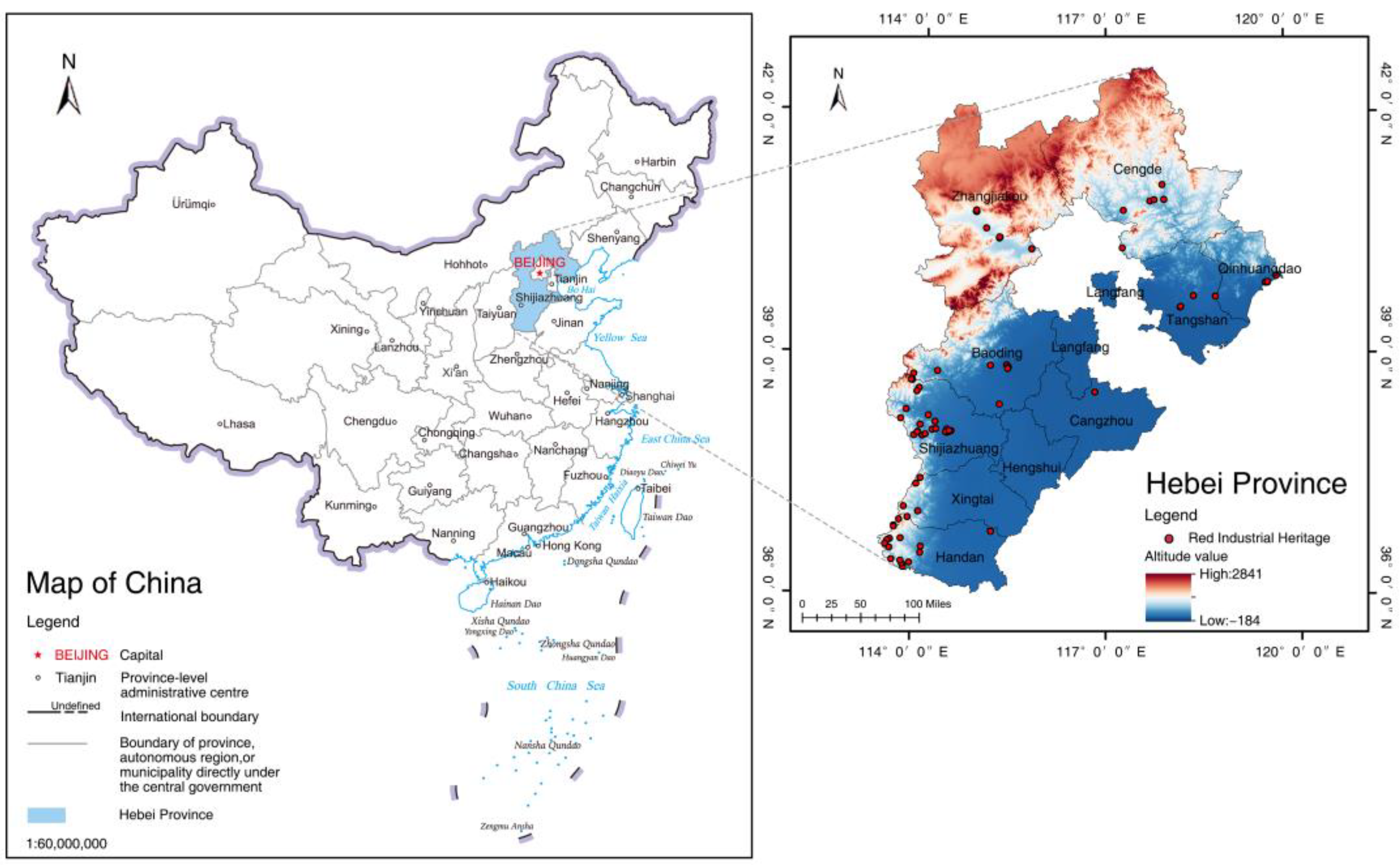
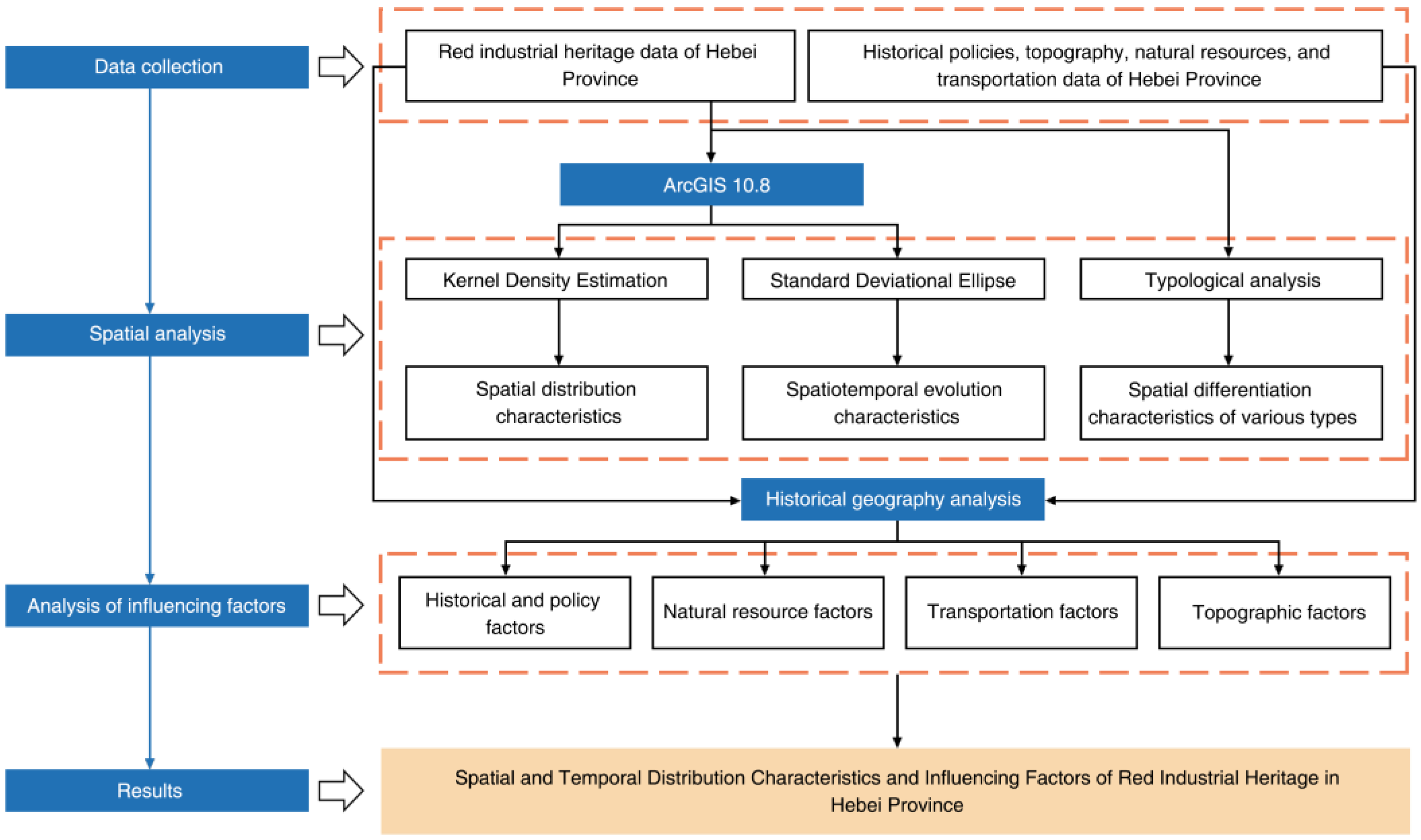
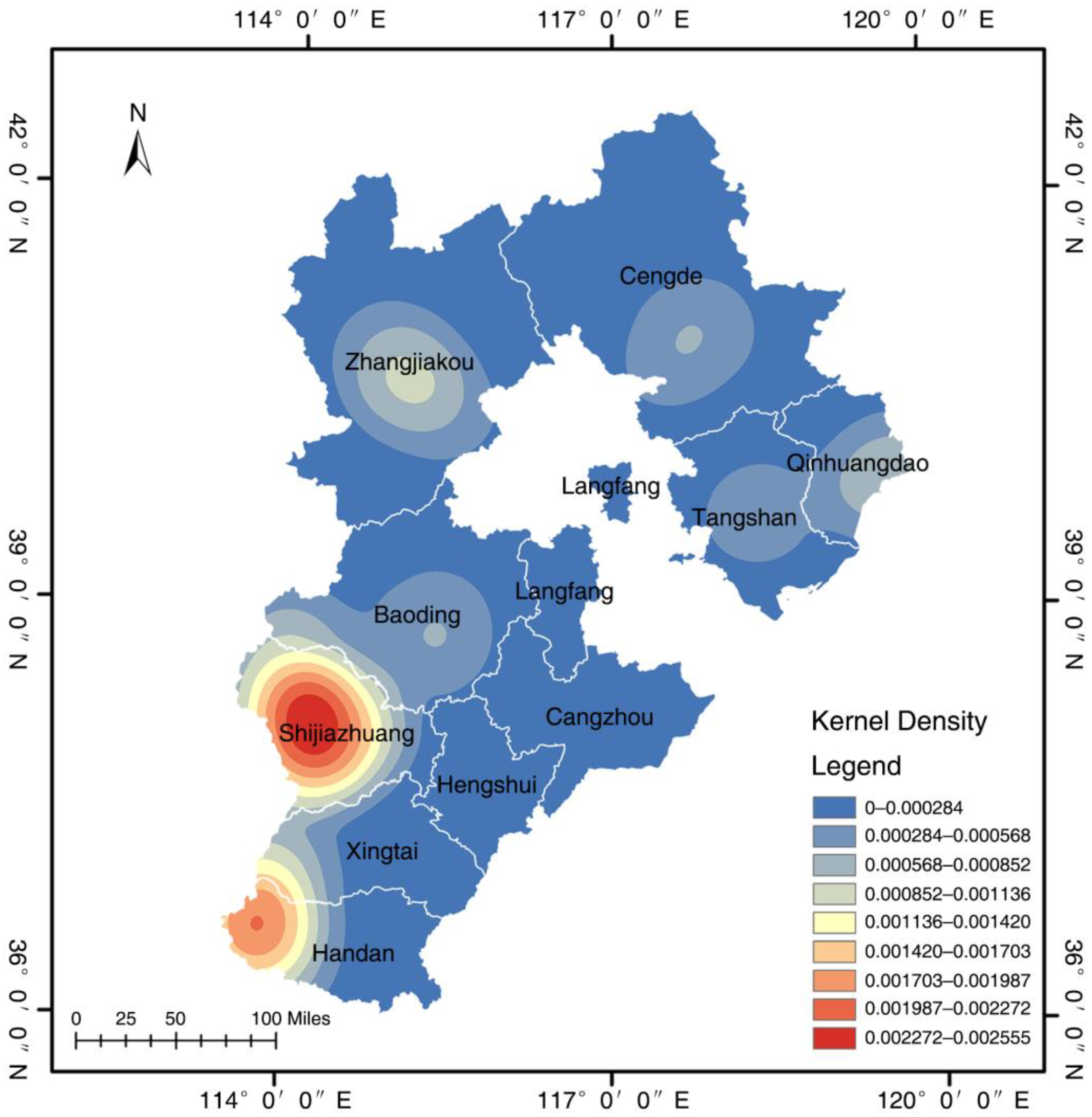
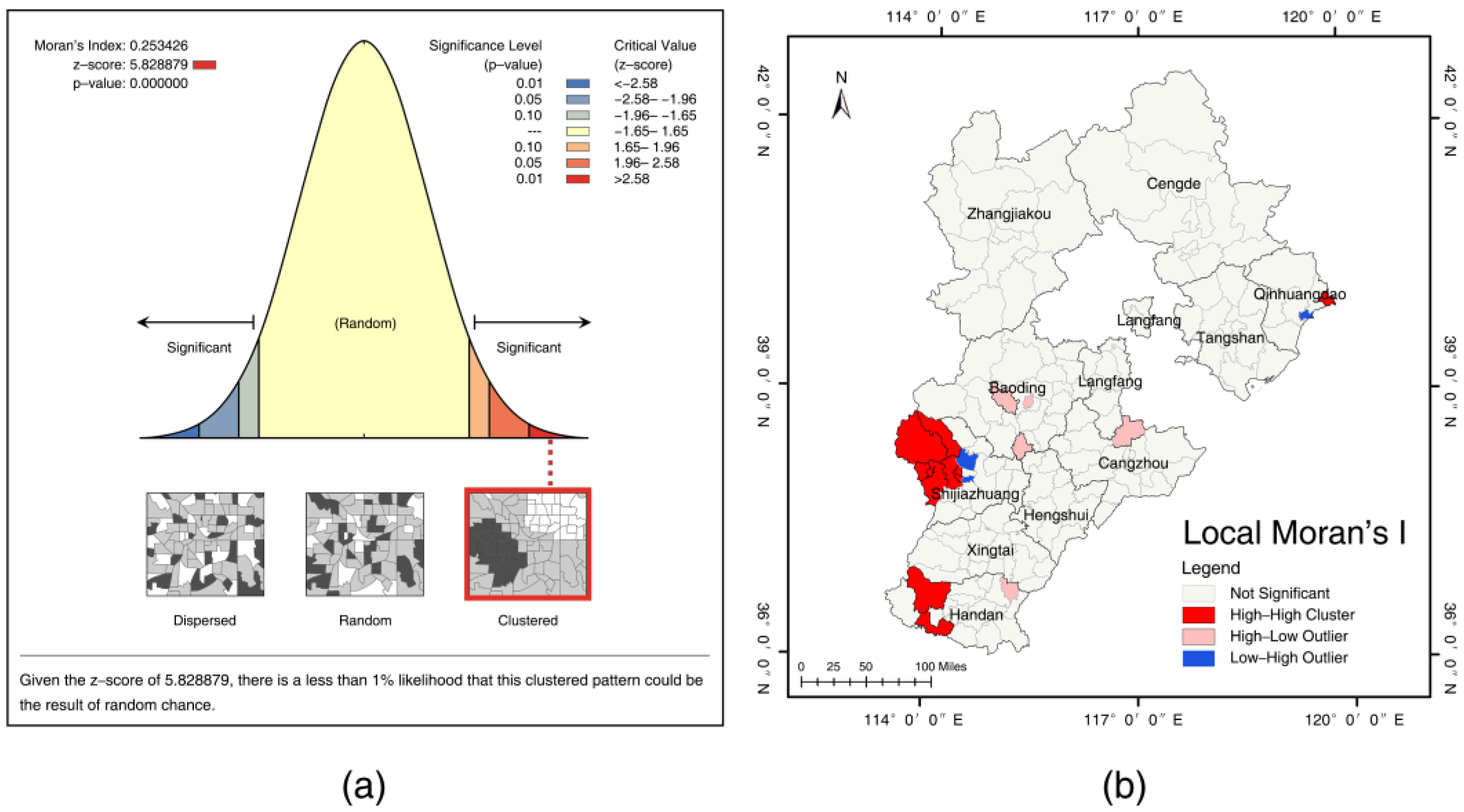
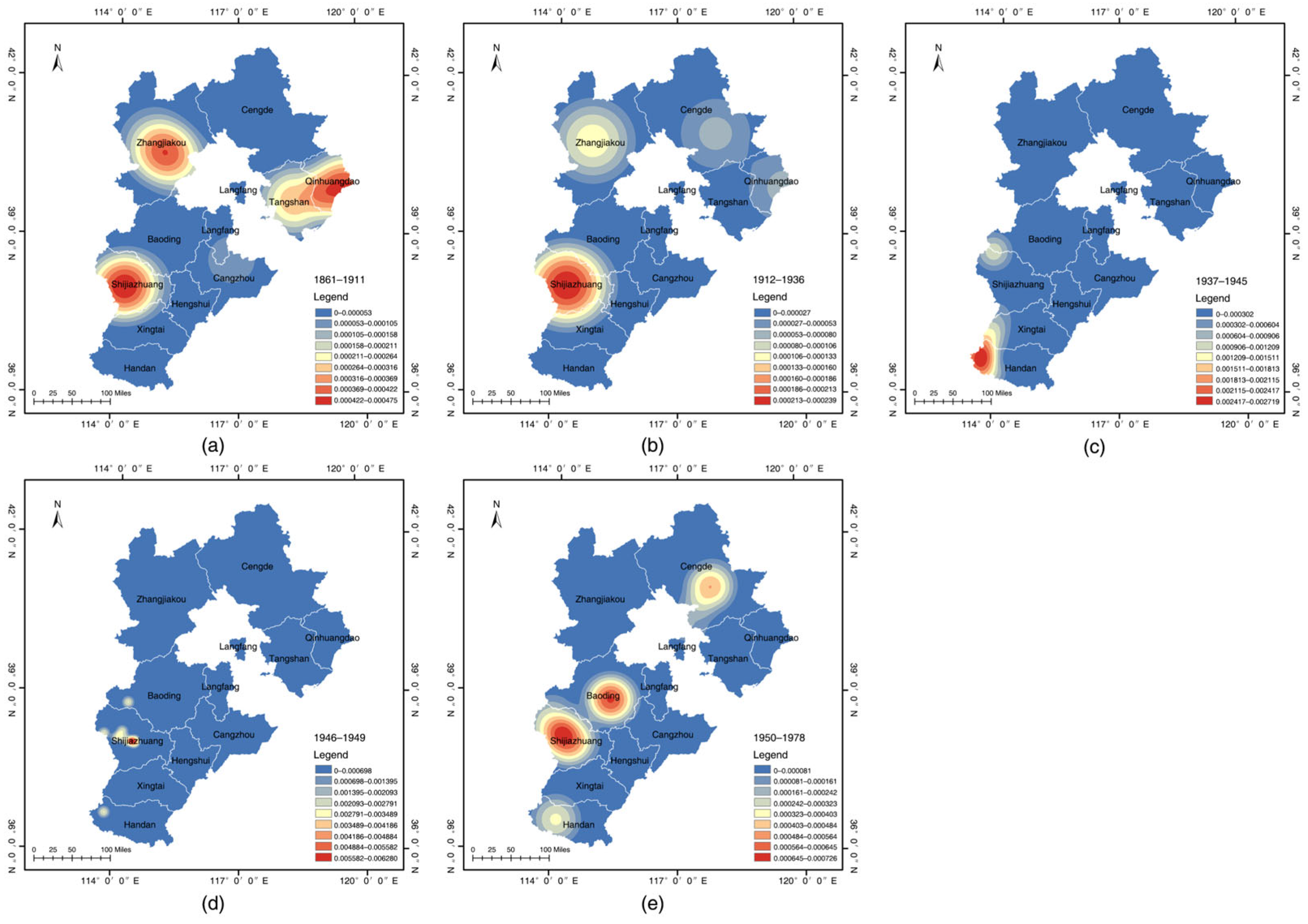
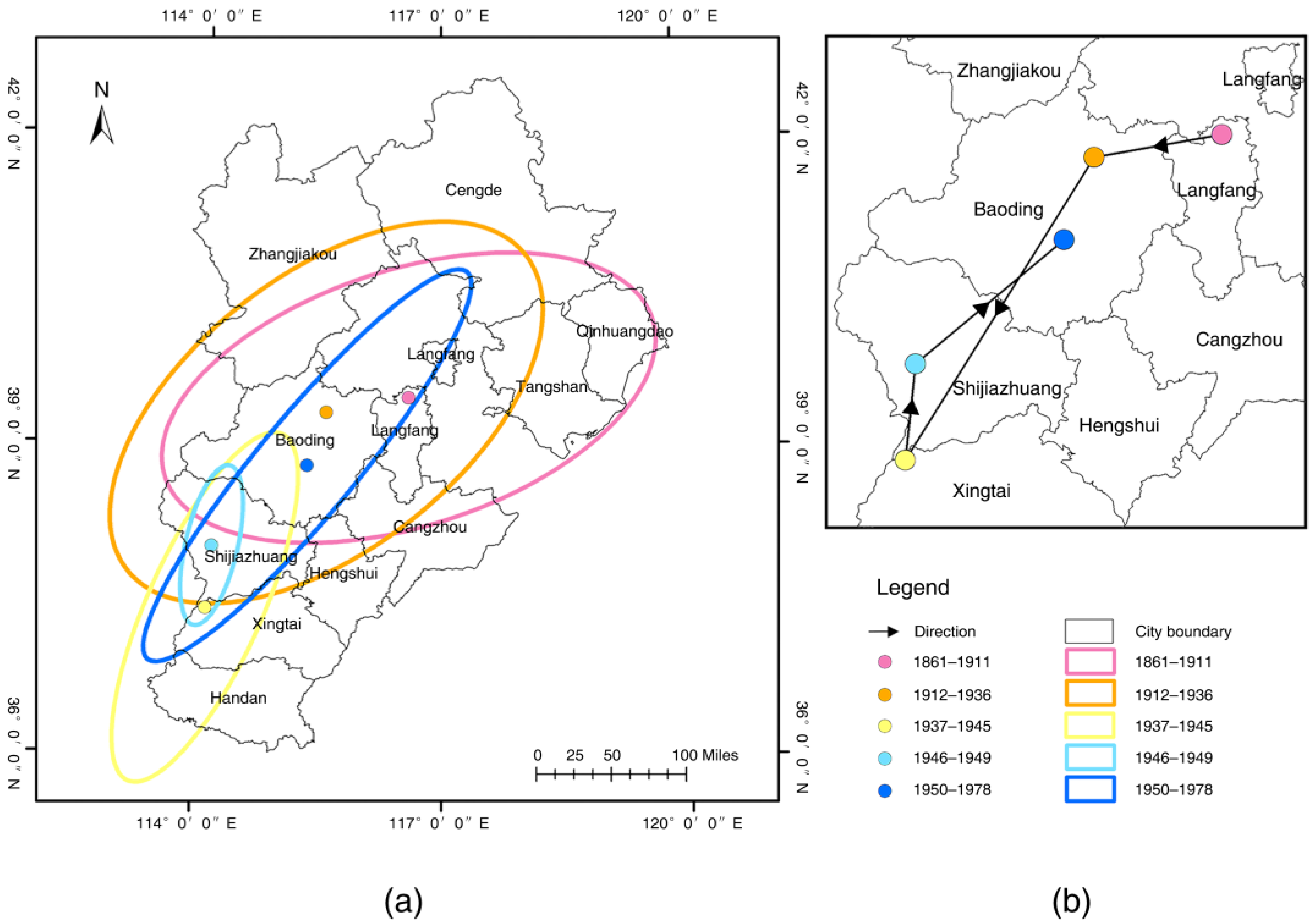
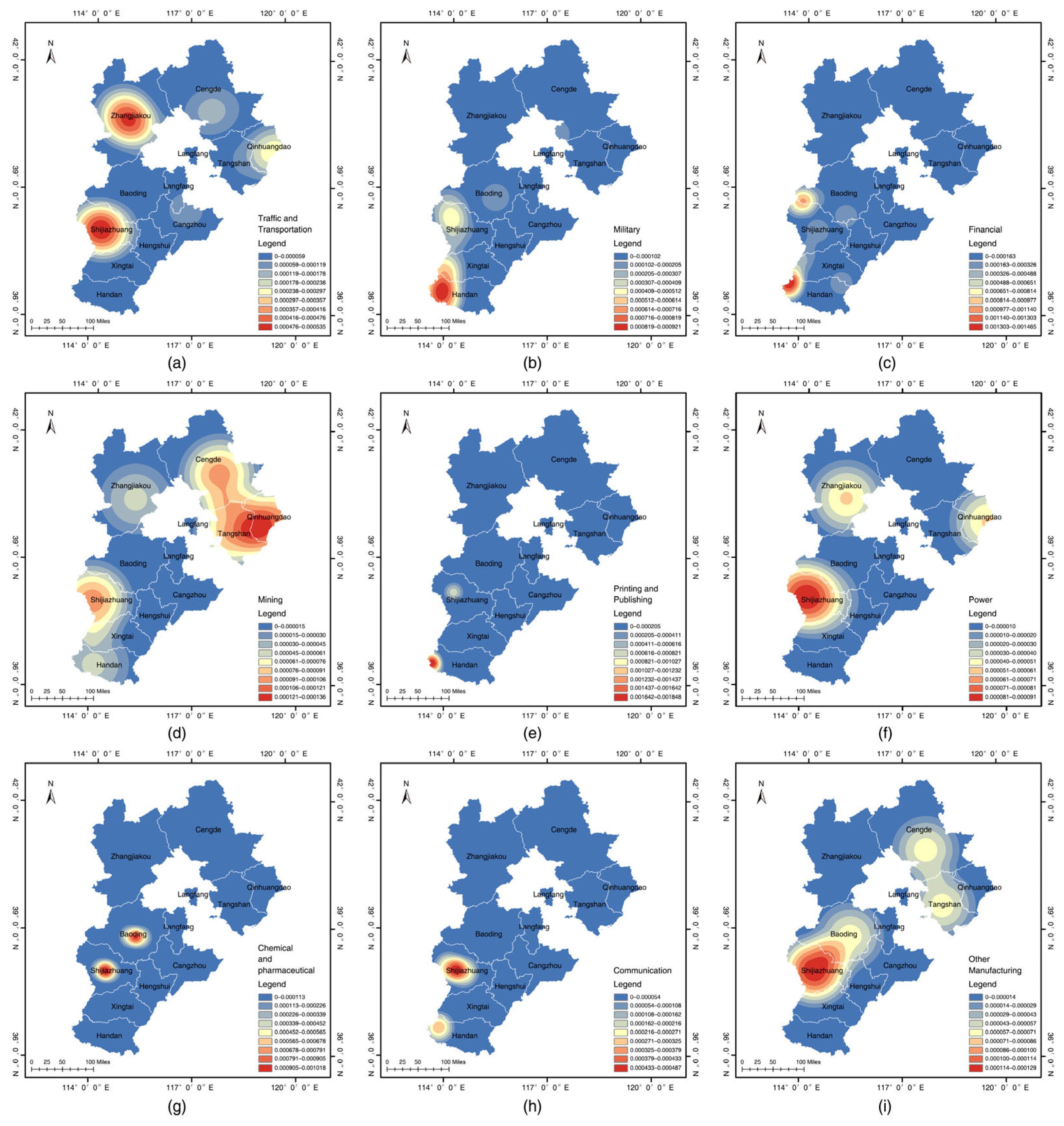
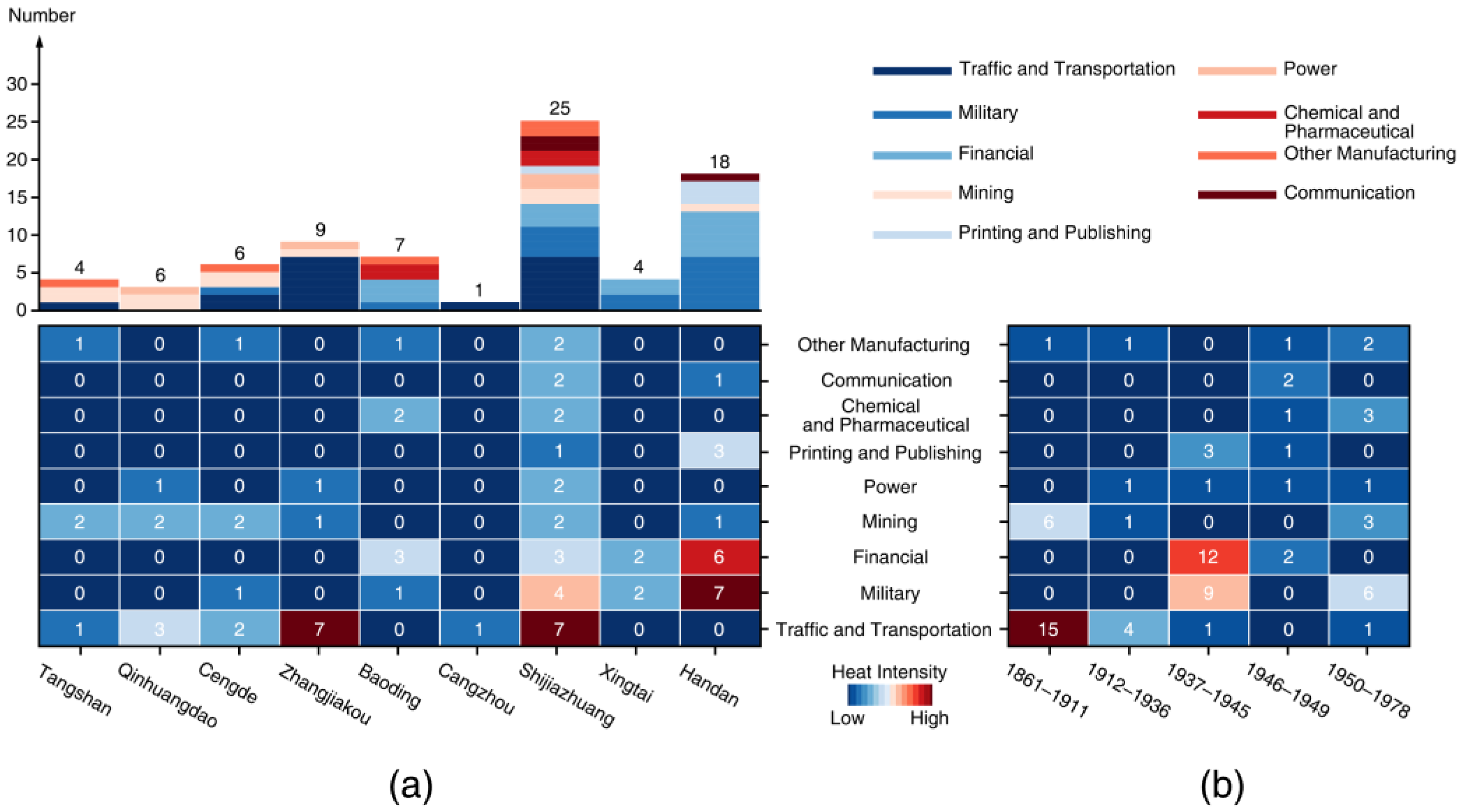
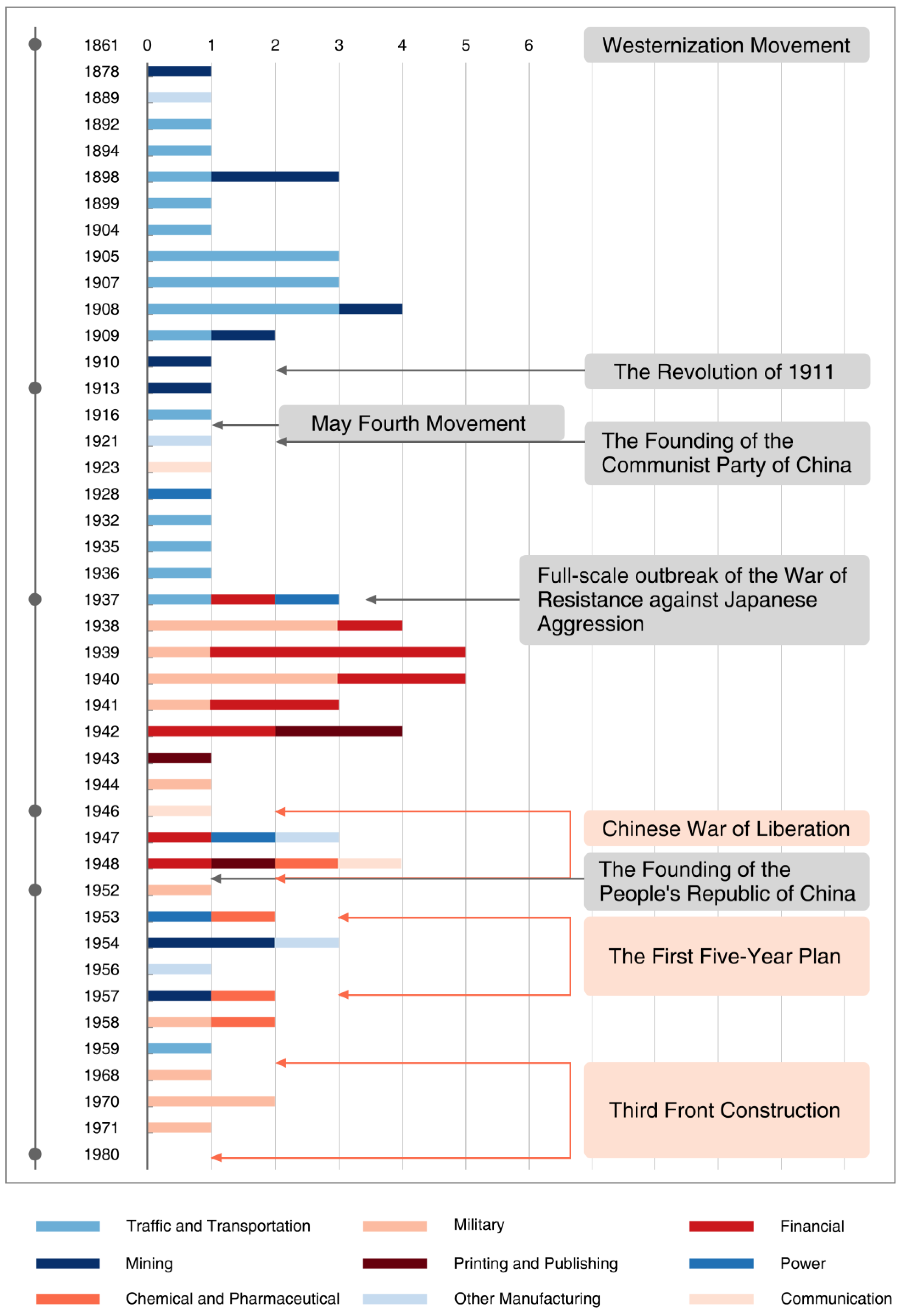
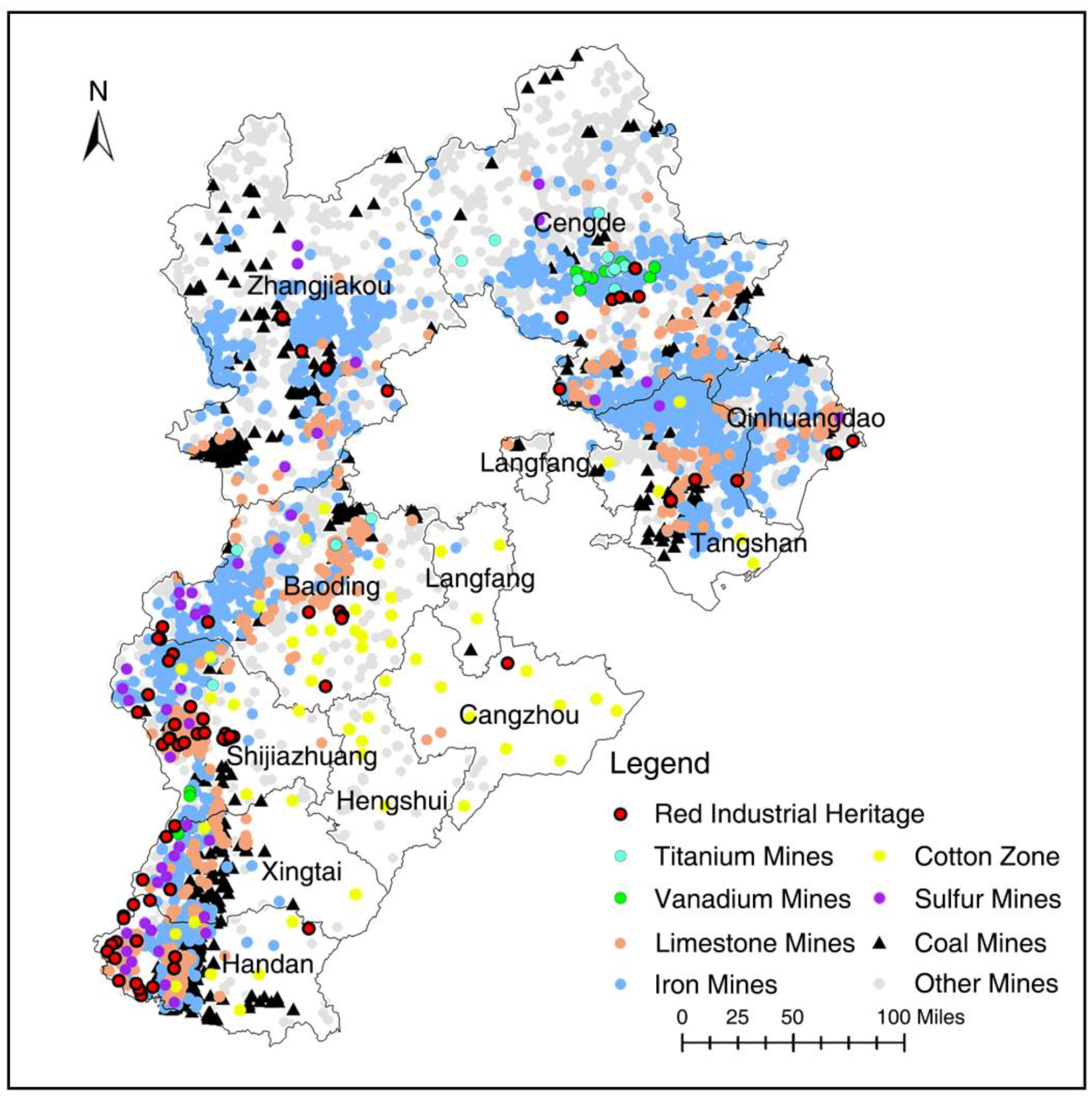
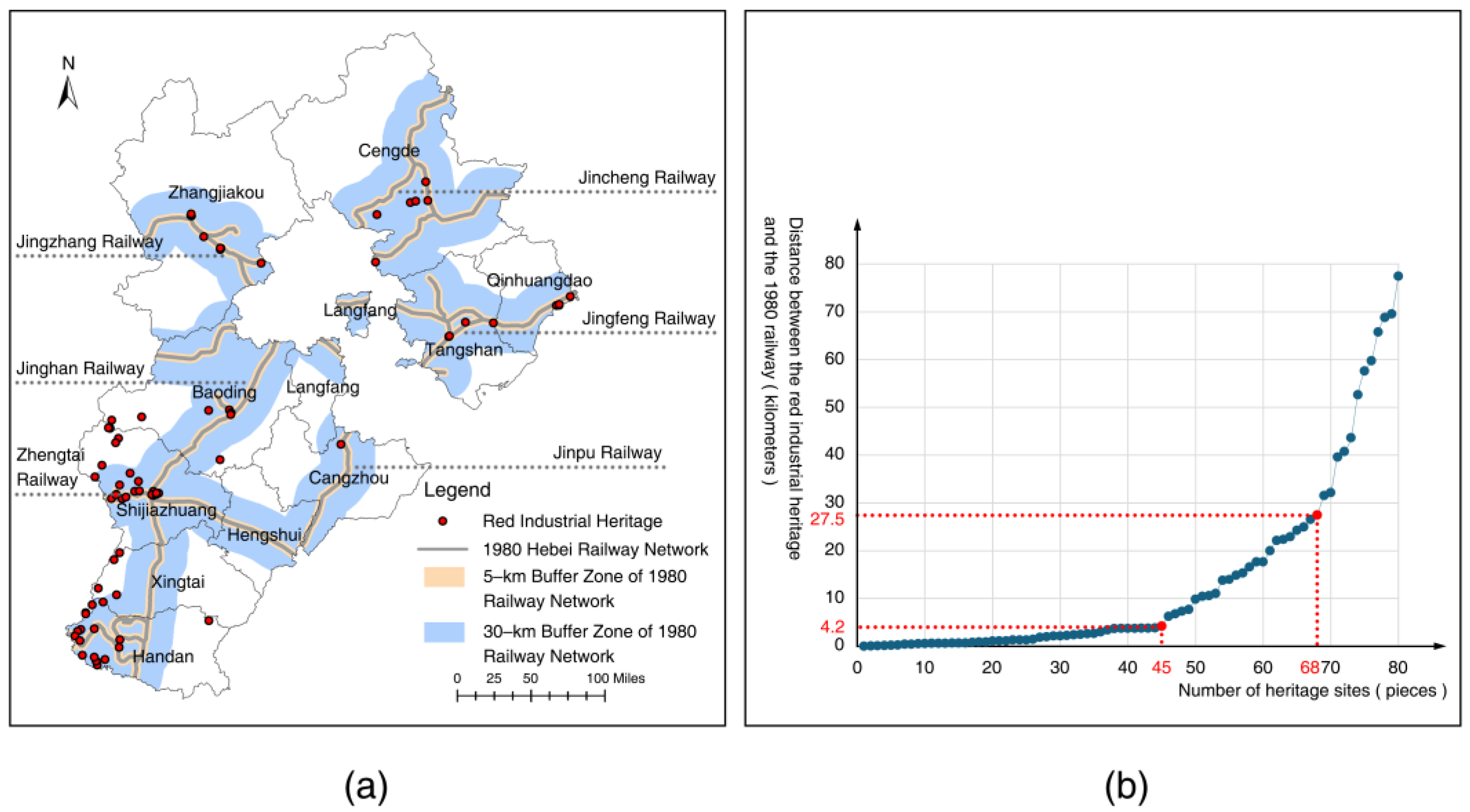
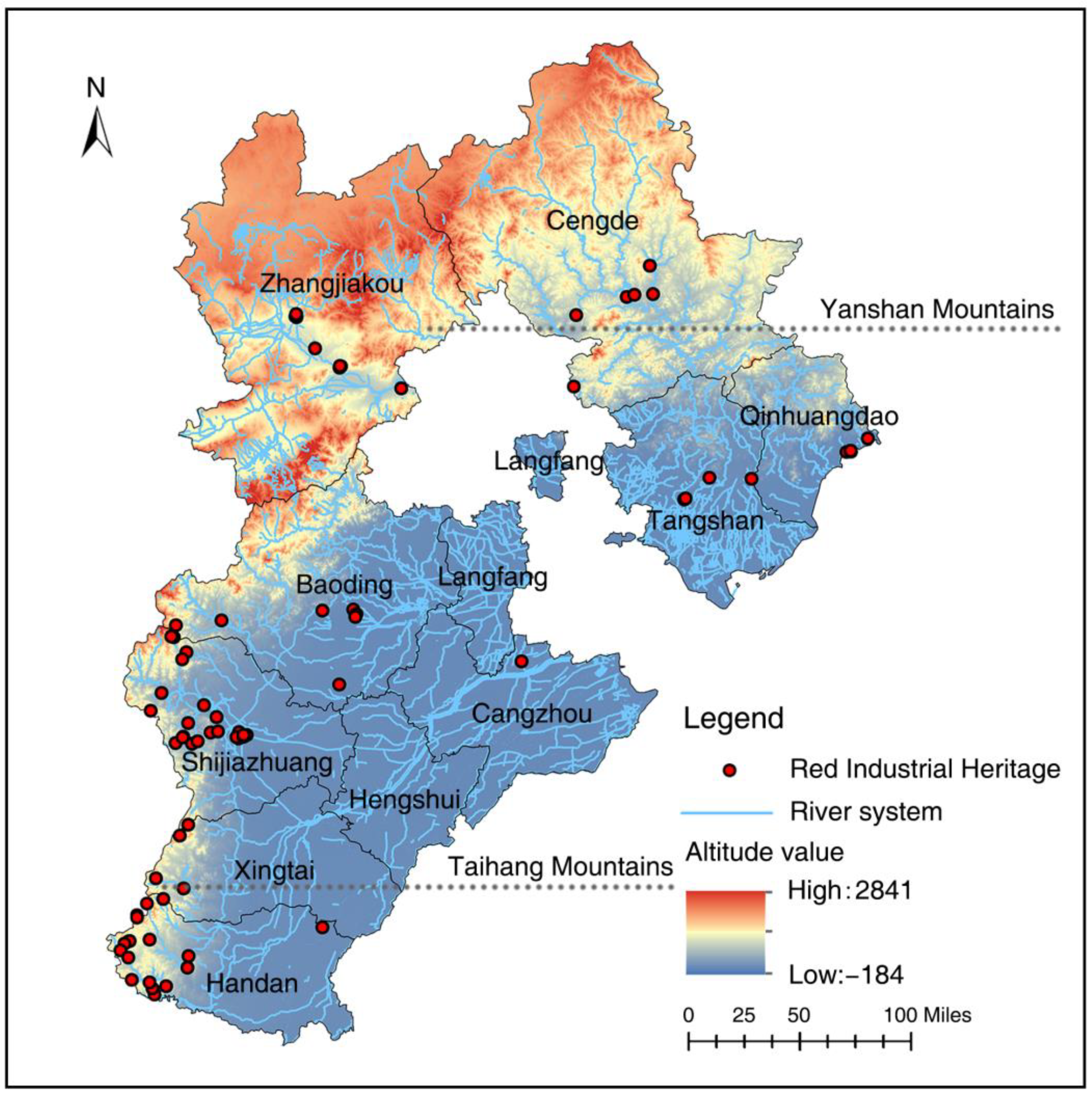
| Historical Stages of the Red Industry in Hebei Province | Time Period | New Additions | Key Events |
|---|---|---|---|
| Modern industrial germination period | 1861–1911 | 22 | 1861: Westernization Movement 1900: Eight-Nation Alliance Invasion 1907: Completion of Zhengding–Taiyuan Railway |
| National industrial turmoil period | 1912–1936 | 8 | 1912: Founding of the Republic of China 1921: Founding of the Communist Party of China 1931: September 18th Incident |
| Wartime industrial forging period | 1937–1945 | 26 | 1937: Full-scale outbreak of the War of Resistance Against Japanese Aggression 1940: Hundred Regiments Campaign |
| Liberation industrial recovery period | 1946–1949 | 8 | 1946: War of Liberation 1949: Founding of the People’s Republic of China |
| Industrialization foundation and transition period | 1950–1978 | 16 | 1953: First Five-Year Plan 1964: Third Front Construction |
Disclaimer/Publisher’s Note: The statements, opinions and data contained in all publications are solely those of the individual author(s) and contributor(s) and not of MDPI and/or the editor(s). MDPI and/or the editor(s) disclaim responsibility for any injury to people or property resulting from any ideas, methods, instructions or products referred to in the content. |
© 2025 by the authors. Licensee MDPI, Basel, Switzerland. This article is an open access article distributed under the terms and conditions of the Creative Commons Attribution (CC BY) license (https://creativecommons.org/licenses/by/4.0/).
Share and Cite
Cao, X.; Liu, X. Spatial and Temporal Distribution Characteristics and Influencing Factors of Red Industrial Heritage in Hebei, China. Sustainability 2025, 17, 7532. https://doi.org/10.3390/su17167532
Cao X, Liu X. Spatial and Temporal Distribution Characteristics and Influencing Factors of Red Industrial Heritage in Hebei, China. Sustainability. 2025; 17(16):7532. https://doi.org/10.3390/su17167532
Chicago/Turabian StyleCao, Xi, and Xin Liu. 2025. "Spatial and Temporal Distribution Characteristics and Influencing Factors of Red Industrial Heritage in Hebei, China" Sustainability 17, no. 16: 7532. https://doi.org/10.3390/su17167532
APA StyleCao, X., & Liu, X. (2025). Spatial and Temporal Distribution Characteristics and Influencing Factors of Red Industrial Heritage in Hebei, China. Sustainability, 17(16), 7532. https://doi.org/10.3390/su17167532







